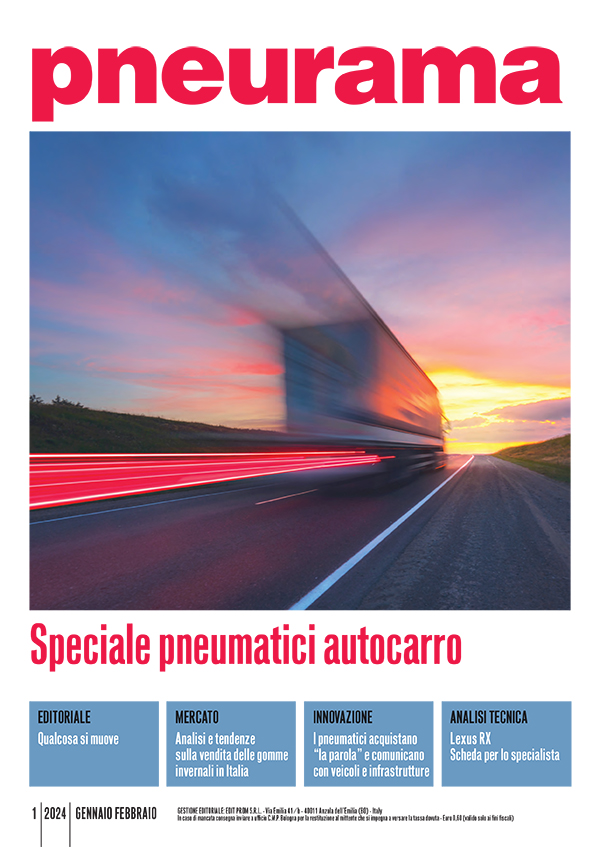Michelin gearing up for carbon neutrality by 2050
The French group’s "All Sustainable Strategy" aims to make industrial processes more efficient and produce eco-responsible products such as Michelin e.Primacy and Pilot Sport EV

Technological innovation and research into materials. These are the two key aspects on which engineers and designers from some of the most important tire manufacturers work to create motorsport tires. Everything starts with a virtual tire which, before becoming a prototype, is tested in simulators where data and variables are loaded to refine its performance. This is a long and labour intensive process with repercussions for the entire road tire sector. We spoke about this with three manufacturers, Falken, Goodyear and Pirelli, who told us how a motorsport tire is created and how much of the research and technology used in this field can be found in the tires used on everyday vehicles.
Falken Tyre
How are racing tires designed?
"Falken Tire's engineers start with a virtual development of the tires which will then undergo a series of simulated tests to make sure they meet the demanding requirements of the motorsport world. At the Nordschleife (Nürburgring’s northern ring), this includes extreme variations in surface, gradients and temperature - which can range between 5°C and 50°C - along with wet, dry and sometimes icy conditions. The new specs are then tested on a car for overall performance and durability before hitting the track for some real testing."
What parameters are analysed during a test?
"When testing the tires, we focus on the performance levels, looking at grip, durability and impact resistance - there are a lot of curbs and uneven sections to deal with on the Nordschleife - as well as its reaction to different temperatures. Equally important is the drivers’ feedback, getting their view on how they “feel” the tires and how these react to the challenges of the circuit."
What kind of materials are used?
"This is a highly guarded company secret, but in general a racing tire has similar materials to a road tire: synthetic rubber, natural rubber, fabric and wire, along with carbon black and other chemical compounds."
What is the hardest part of developing a race tire?
"Balancing grip, wear, load and finding the 'sweet spot' in terms of performance is the hardest part of the work. The unpredictable nature of the Nordschleife means we have to be prepared for all kinds of situations."
What kind of technological innovation can be found in a motorsport tire today?
"Improving the life span of a tire without neglecting safety and performance levels is the biggest technical challenge, and in order to achieve this Falken is using its patented 4D Nano technology, which looks at the compound at a nanoparticle level."
What are the main differences from a street tire?
"In motorsport, we have different tires for very specific situations, “slick” tires for dry weather, “intermediate” options for those uncertain conditions between dry and wet, and “rain” for wet tracks. The tire characteristics and performance are very specific and we change them depending on track conditions. In a normal road tire, you cannot be that specific, so we have to work on all-round performance for a wider range of conditions. In motorsports, tires have a lot of rubber and are lighter, but they are made to handle extreme forces."
How much of this technology is actually transferred to a street tire and what does it consist of?
"The Nordschleife is one of the most difficult testing grounds for tires. All the innovations developed to make the tires last longer, while maintaining safety and performance levels, are interesting and applicable to the street tire market."
Goodyear
Research on materials, information exchange between engineers and teams not to mention testing. The American multinational designs its motorsport tires by combining different technologies in order to obtain tires suitable for every kind of competition without neglecting to keep an eye on road tire. To understand what the work consists of, we spoke with Piero Gennari, Goodyear consumer marketing manager.
How is a motorsport tire designed?
"The work of creating a motorsport tire is divided into three phases: first the design, in which a vital series of data and characteristics necessary for designing a virtual tire are analysed; the second phase involves making prototypes; and then the last step where we test the tires on a race track. However, all these steps take place at specific times that are mutually agreed between the organizers of the championships and the teams that participate in them. In fact, when our engineers work on motorsport tires, they need a series of information to create a specific tire for the category for which it is intended. For example, a tire designed for an endurance race, where stints are on average very long, is different from a tire used for a touring competition where races are much shorter. During the design phase, elements such as the type of vehicle, size, weight and downforce, i.e. the aerodynamic load on the tires, are taken into consideration, along with other data on the composition of the materials".
What kind of materials are used and how important is the exchange of information between those who design and those who test the tires?
"The materials used do not really differ from road tires. What changes is the combination of materials used in the production of the final product. Speaking about race tires, we often find strong similarities with Uhp road tires such as our Eagle F1 SuperSport. The percentage of a specific material, for example rubber, steel, Kevlar or nylon, just to name a few, is linked to the use and performance we are looking to obtain. That is why, before talking about materials, we must speak with the team that will use the tire. This is necessary because, once the prototype is made, we can understand, while testing, whether we are within the performance parameters that we had set ourselves".
What kind of technological know-how can we expect to find in a race tire and how much of that is then used on road tires?
"During a race, time is a fundamental element, from lap times to pit stops. In both cases, tires will have a significant impact: think of the wear due to the number of laps a car completes. Being able to run more laps with the same tire and stopping just to refuel gives teams a fundamental advantage in the race. The technologies we use in motorsport tires are focused on making it as durable as possible while maintaining the same performance until the very end. To do this, we work on structure and compounds in order to control the working temperature and reduce the risk of the tire behaving unpredictably. An R&D work that we have also used in road tires such as, for example, the EfficientGrip Performance 2, a high-performance tire for medium-sized cars that has been designed to guarantee consistent performance in different conditions and a longer lifespan. However, the transfer of technology and research also happens in reverse. In the case of the Pure Etcr championship, we were asked to create a tire that could be used throughout the championship, in different temperatures and in both dry and wet conditions. The end result was a tire that is very similar to our Eagle F1 SuperSport. When it comes to using technologies we must avoid thinking in terms of compartments, rather we need to integrate all our know-how in order to achieve the results we have set ourselves".
Pirelli
Material analysis and simulations on virtual prototypes: for Pirelli, the process of designing and developing sports tires begins within the walls of a research lab. To understand the work of technicians and engineers, we spoke with Stefano Bizzi, Pirelli's R&D motorsport manager.
How is a motorsport tire designed?
"It all starts with a drawing and a simulation process. We work on tires reproduced in a virtual environment where we study their characteristics. Following this, we outline a realistic model and start collecting data on the behaviour of the tire in terms of stress, stiffness and geometry of the footprint. The result is a virtual prototype with characteristics that resemble those of a real tire. It should be noted that the decision to adopt this type of development is linked to the reduction in the number of on-track testing in order to contain development costs, in any case the objectives are assigned through a target letter shared with FIA-FIOM, or other providers".
When designing a tire you work through simulations, can you explain what this is all about?
"Starting from a drawing, we proceed by gradually adding the constituent elements of a tire and, each time we add a new element, we monitor its behaviour based on variables. That way we can analyse temperatures, loads, forces and footprint geometry and correct our virtual prototype each time. Once we end up with a tire that meets all the required characteristics, albeit virtual, we proceed with simulated testing on a reference vehicle. This step allows us to set the parameters on several tire families with different characteristics. Once the test is over and the best solutions have been found, the data collected on the virtual tire can be sent to the teams and/or reference providers who will in turn carry out simulations and tests adding their own variables mainly linked to the vehicle. All these steps could be repeated many times, as each department working on this model analyses the tire according to its skills and expertise and then exchanges information.
A tire is made of different types of materials. How do you manage to reproduce their characteristics during simulation?
"In our labs we prepare fabric or compound samples from which prototypes are made. These are then subjected to thermal and deformation stress tests in order to evaluate the material itself. This data will be useful in the design phase of the virtual tire. Once all the information has been acquired, we begin the construction phase of the virtual tire, using the materials that can guarantee the best performance".
When do you move on to physically testing the tires?
"Once all these steps have been completed, we create physical prototypes that are first tested on indoor testing machines to verify that the structural stiffness, geometry of the footprint and tread resistance are comparable to what was analysed during the simulation phases. If these are confirmed, then we take the tires to a testing ground. Once there, lap times, tread degradation and performance consistency will be evaluated. In this last step, telemetry, loads, temperature, casing and tread stress are monitored to understand if there is any abnormal wear or tear".
How much of this work is useful for road tires?
"Our studies on materials, mass and weight reduction, especially in Premium tires where maximum speeds (except for vertical, lateral and aerodynamic loads) are very close to those we can find in Formula 1, can be used to improve road tires. However, nowadays we are also having to deal with electric vehicles, cars with higher torque and greater weight. In this case, the studies carried out on forces, tread wear and footprint can be useful for us in producing the next generations of tires.
The French group’s "All Sustainable Strategy" aims to make industrial processes more efficient and produce eco-responsible products such as Michelin e.Primacy and Pilot Sport EV
Tires are the only vehicle components that actually touch the road. In an era where connectivity is becoming a staple in automotive, Connected Tires will quickly become your tire dealer’s new allies
Efficiency and environmental sustainability are the objectives set by the new general director of Ecopneus, Federico Dossena, to promote and boost tire recycling
